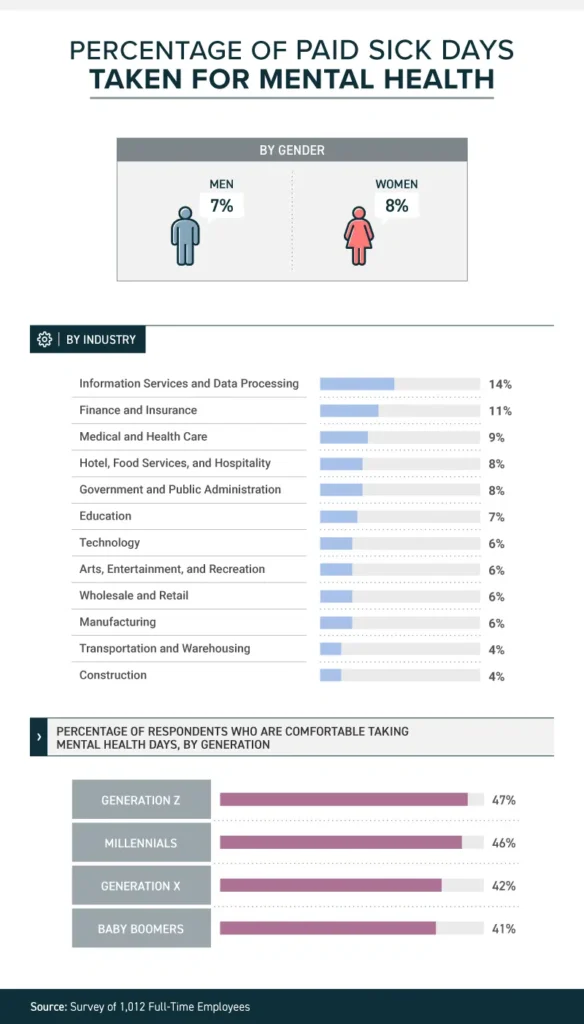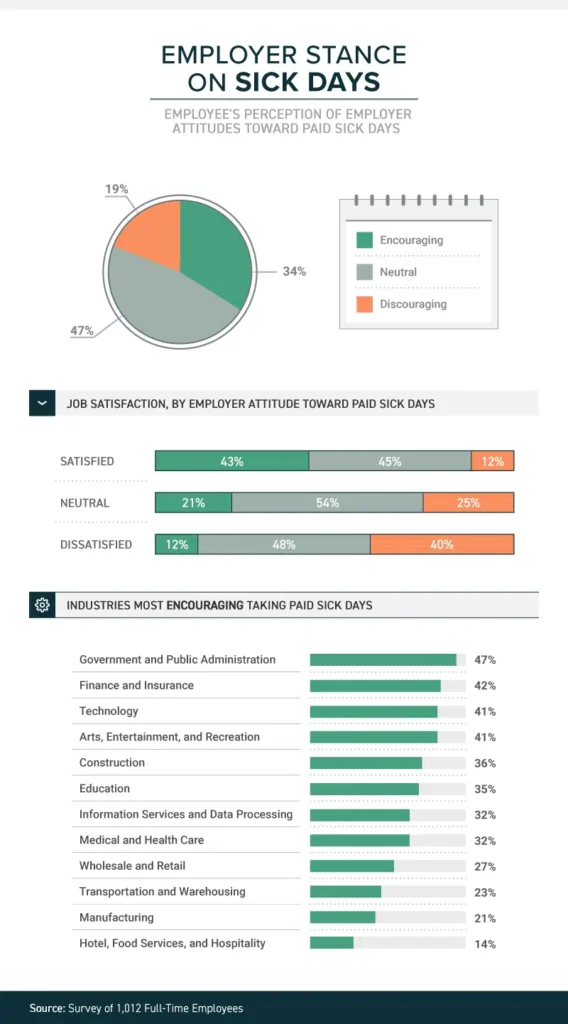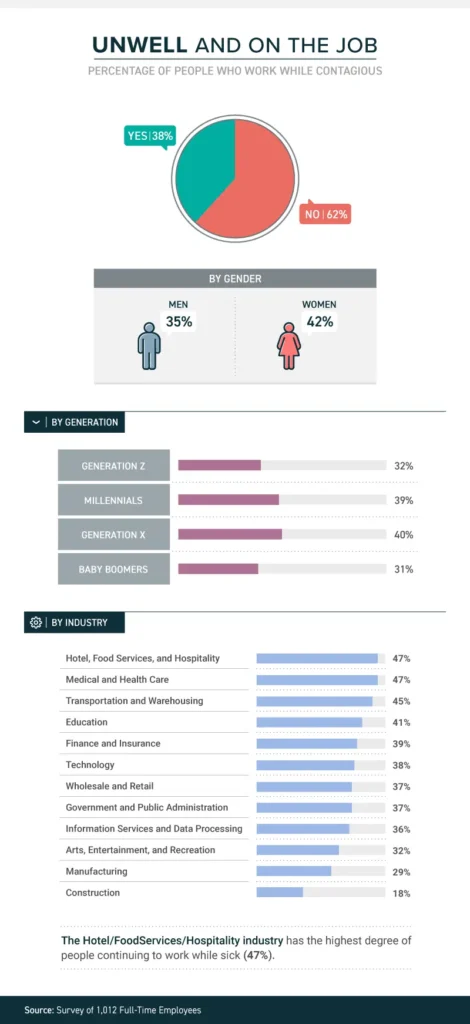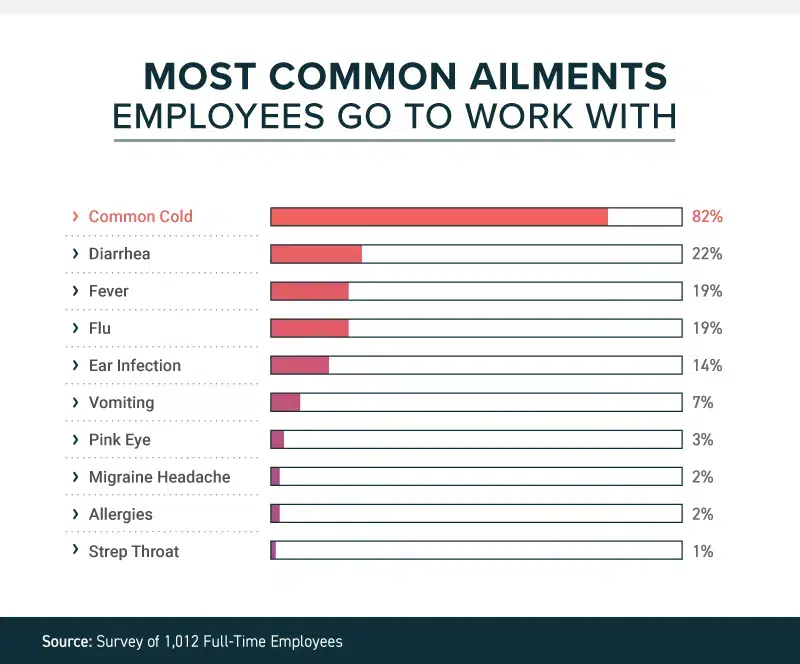While most part-time employees aren’t granted sick hours for days when they might be ill or need to care for family members, even employees who have the option to stay home when they aren’t feeling well don’t always take it. Whether it’s the fear of becoming replaceable or simply feeling like you have too much work to do, it’s not uncommon to feel guilty about calling out on the job.
But does this mentality apply to all industries equally? To find out, we surveyed over 1,000 full-time employees to find out how much sick time they’re allowed to take, how many days they use over the course of the year, and for which types of conditions (mental and physical) they’re willing to take time off. Read on as we unpack how many people are working when they’re contagious and how far they’re willing to go to avoid missing time for their jobs.

Time to Recuperate
If you’ve got a cold or are running a fever, your body is trying to tell you something. And even when you think those symptoms might have dissipated, there’s a strong chance you haven’t completely recovered from whatever has been working through your system. The Centers for Disease Control and Prevention (CDC) actually recommends that a person with a fever stays home for an additional 24 hours after their temperature has abated, and even longer for high-risk adults and children.
But that might not always be an option. While the average body needs 10 full days to completely recover from a cold, not everyone has that much time to spend. Roughly 1 in 10 full-time working Americans don’t get any sick days at all, and more than 1 in 4 get between just one and five days of approved time off for their health. Less than 1 in 5, 18 percent, are permitted between 11 and 15 days off from work should they get sick.
If you work in government or public administration, education, or IT and data processing, you might consider yourself lucky. Across the more than 1,000 people we surveyed, these industries reported the highest average days off for sick time, between 10 and 12. While not universal, a small percentage of employees working in finance, arts and entertainment, and retail actually acknowledged being granted an unlimited number of sick days by their respective companies.

A Different Kind of Condition
Running a temperature of 103 degrees is one thing (and still sometimes not enough for people to consider calling in sick), but your mental health is something else. Conditions like anxiety and depression are real, yet the stigma surrounding mental health often acts as a barrier between knowing something is wrong and seeking help for these illnesses.
When asked how comfortable they were taking off time from work to tend to their mental health, fewer than 1 in 10 men and women were willing to call out. While some industries may have created a safer working environment for people to open up about their mental health, just 8 percent of women and 7 percent of men said they were willing to use their sick time to cover their mental and emotional needs.
At most, just 14 percent of people working in information services and data processing would take personal mental health days, followed by 11 percent of people in finance and insurance and 9 percent of those working in medical and health care. Still, some of these perceptions might be changing. Younger generations (including both millennials and the even younger Generation Z) were more likely to take a respite from work for their mental health than Gen Xers or baby boomers.

Down and Out
So how many people are actually cashing in on their sick days at work? More than half of full-time baby boomers (60 percent), Gen Xers (59 percent), and millennials (53 percent) said they use some of their sick time, but ultimately have days or hours left over at the end of the year. Baby boomers were also the least likely generation to run out of sick days and the most likely to not take time off for their health at all. And while more than 1 in 5 Gen Zers run out of sick days completely, more than 1 in 4 weren’t afforded time off for their personal health in the first place.
Overwhelmingly, the most common reason for using sick leave was in response to an illness. Another 15 percent said they used sick days for either vacation or general time away from work (commonly known as playing hooky). If that sounds like an abuse of the system, consider this this tidbit: Clocking too many hours at the office can actually start to take a physical toll on your body. Not only will you start to feel less productive, but your mental and physical health could take a beating, too.

The Impact of Company Culture
Whether it’s taking time off because you aren’t feeling well, scheduling a family vacation, or even having a baby, it’s not uncommon for working Americans to feel guilty about being away from the office. Those stigmas surrounding taking time off can sometimes feel ingrained into company culture, making it even more difficult to rationalize why getting away can actually be good for your health.
Overwhelmingly, full-time employees perceived their employers as having a neutral position on using approved sick time. That neutral stance on allowing team members to care for themselves can sometimes turn into a dwindling sense of job satisfaction which was typically more common among people working in government, finance, and technology.
Roughly 1 in 3 employees described their employers as encouraging toward necessary sick time, and 43 percent of those people also rated themselves as satisfied with their jobs in general. Among companies with a neutral stance, satisfaction fell to 21 percent, and for the nearly 1 in 5 people who felt like their companies discouraged them from taking time off for their health, job satisfaction was just 12 percent.

Spreading Germs
It’s easy to identify when you’re not feeling well, but what about when that cold is so severe that you might be putting your co-workers, clients and even customers at risk by showing up to work sick? Recognizing the symptoms of a contagious cold can be tricky, especially if you don’t have time to see a doctor to discern what’s really going on. Generally speaking, a runny nose, high fever, or irritable cough can be clear indications that your presence could be hazardous to the people around you (especially since you can be contagious for up to two weeks).
Despite knowing they could infect their co-workers or customers, 38 percent of full-time employees are still willing to show up to work when they’re contagious. More common among women (42 percent) than men (35 percent), people working in hospitality, medical and health care, and transportation had the highest likelihood of bringing their colds into work with them, even if it meant getting other people sick as a result.

Hazardous Work Conditions
Have a runny nose or a sore throat? Even that should be enough to consider staying home from work in some cases. While more than 4 in 5 employees were willing to go into work with what they believed was the common cold, those germs still have the potential to spread to their co-workers and customers. In fact, you could be contagious with a cold a full day before you start to exhibit symptoms, and may stay contagious a full two weeks thereafter.
Another 1 in 5 would go into work with diarrhea, a fever, or the flu. Medical experts recommend people stay home from work or school when exhibiting any of these symptoms as they could be contagious and involve potentially dangerous strains of bacteria. But there were some ailments most people were willing to stay in bed with. No more than 3 percent of people would work through strep throat, allergies, a migraine, or pink eye.
Prioritizing Your Health
No matter what kind of industry you work in, prioritizing your health can be as important for your personal wellness as it is for your professional success. Putting too many hours in at work or showing up when your body is telling you to stay home usually means you aren’t putting your best foot forward. Still, calling in sick may not always feel like the right solution either.
While a majority of full-time employees receive at least some sick days from their employers, they aren’t guaranteed. And even having them available to you doesn’t always mean you’re going to be willing to use them. As most people told us, even when they’re offered sick time, they don’t typically use it all. Most employees are even more cautious about calling out when their mental health is in question, and even being contagious isn’t always reason enough to stay home for some. Considering how contagious you could be without even realizing it, it’s generally better to be safe than sorry when it comes to protecting your own health and being courteous to the people working around you.
Methodology
We collected 1,012 Americans who are employed full time from Amazon’s Mechanical Turk. Fifty-four percent of our participants were men and 46 percent were women. Participants ranged in age from 18 to 76 with a mean of 35 and a standard deviation of 10. The data we are presenting rely on self-report. There are many issues with self-reported data. These issues include, but are not limited to the following: selective memory, telescoping, attribution, and exaggeration. No statistical testing was conducted, so the claims listed above are based on means alone. As such, this content is purely exploratory and future research should address this topic in a more rigorous way.
Sources
- https://www.marketwatch.com/story/55-of-american-workers-dont-take-all-their-paid-vacation-2016-06-15
- https://fortune.com/2017/05/02/paid-sick-days-us-workers/
- https://www.thehealthy.com/cold-flu/how-long-does-a-cold-last/
- https://www.nami.org/Blogs/NAMI-Blog/October-2017/9-Ways-to-Fight-Mental-Health-Stigma
- https://www.healthline.com/health/working-too-much-health-effects#3
- https://www.dol.gov/general/topic/workhours/sickleave
- https://www.forbes.com/sites/johnhall/2016/07/31/why-its-hard-for-driven-people-to-take-time-off-and-what-they-can-do-about-it/#7712c32e407c
- http://www.cbc.ca/dragonsden/blog/contagious-with-a-cold-or-flu
- https://www.verywellhealth.com/how-long-is-a-cold-contagious-770453
- https://www.healthline.com/health/cold-flu/contagious#when-to-stay-home
Fair Use Statement
Looking for a polite way to tell your co-workers not to bring their cold into the office with them? Feel free to share the results of our survey with your readers for any noncommercial use. We only ask that you include a link back to this page so our contributors get credit for their work too.


















